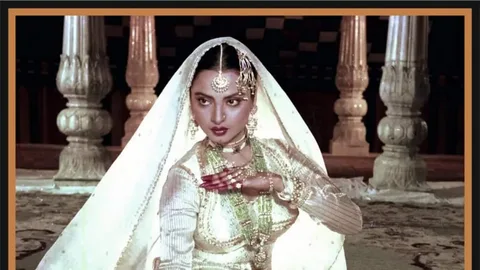Indian cinema is experiencing a powerful revival, and the spotlight is firmly on restoration. At the 55th International Film Festival of India (IFFI) in Goa, post-production giant Prasad is presenting ten beautifully restored classics, including the iconic ‘Umrao Jaan’ (1981) led by Rekha. These films aren’t just upgraded for modern screening—they represent India’s cultural memory and the artistic journey of generations. This critical analysis explores why these restorations matter, how they were executed, and what they signal for the future of South Asian cinema.
The Big News – ‘Umrao Jaan’ Leads the Lineup of Restored Indian Gems
The crown jewel of the showcase is Muzaffar Ali’s ‘Umrao Jaan’, a film that shaped cinematic expression with its poetry, music, and strong emotional depth. Rekha’s portrayal of the 19th-century courtesan remains one of Indian cinema’s finest performances, and the restoration makes it accessible to modern audiences with enhanced clarity.
Why Restoring ‘Umrao Jaan’ Matters Today
‘Umrao Jaan’ holds cultural weight—it’s a film that bridges Urdu poetry, Indian classical arts, and the emotional resilience of women. Restoring it:
-
Protects a national treasure
-
Introduces new generations to Rekha’s brilliance
-
Preserves the original aesthetic and emotional tone
-
Ensures global festivals can screen a high-quality version
Technical Brilliance Behind the Restoration
Prasad’s team used:
-
Digital restoration tools
-
High-level color grading
-
Picture and sound quality control
-
Fidelity preservation techniques
Their focus was maintaining authenticity while upgrading the viewing experience.
Full List of the 10 Restored Films at IFFI 2025
This carefully curated selection spans decades of cinematic evolution and reflects various storytelling styles that shaped Indian cinema.
The 10 Restored Indian Classics
-
Umrao Jaan (1981) – Muzaffar Ali
-
Gaman (1978) – Muzaffar Ali
-
Rudaali (1993) – Kalpana Lajmi
-
Subarnarekha (1965) – Ritwik Ghatak
-
Muraliwala (1927) – Baburao Painter
-
Party (1984) – Govind Nihalani
-
Pyaasa (1957) – Guru Dutt
-
Susman (1987) – Shyam Benegal
-
Kireedam (1989) – Sibi Malayil
-
Musafir (1957) – Hrishikesh Mukherjee
Critical Analysis – Why These Films Were Selected
The film curation highlights:
-
Diversity of themes
-
Representation of multiple eras
-
Contributions from directors who defined cinematic language
-
Performances that shaped Indian acting standards
The lineup reflects India’s cultural, political, and emotional storytelling legacy.
The Most Technically Challenging Restorations
Early films like Muraliwala (1927) and politically charged films like Subarnarekha (1965) required deep digital repair, sound reconstruction, and advanced preservation—the kind of restorative work only experts can manage.
How Prasad Became a Global Powerhouse in Film Restoration
Prasad is not just a company—it’s a 70-year-old institution in Indian cinema.
A Brief History of Prasad
-
Founded in 1956 by L.V. Prasad
-
Worked on over 30,000 films
-
Global facilities in India, U.S., U.K., Japan, Germany, Saudi Arabia
-
Offers services like 8K restoration, HDR grading, DI, and Dolby Atmos mixing
Why Prasad Leads the Restoration Industry
Prasad maintains leadership because it combines:
-
Technical innovation
-
Deep archival knowledge
-
Generational experience
-
Partnerships with NFDC and NFAI
This gives Prasad access to films that require care, precision, and understanding of cultural nuances.
Film Restoration as Cultural Responsibility
Abhishek Prasad described it as both “responsibility and privilege,” and that perfectly captures the heart of the work.
What Film Restoration Really Means
-
Preserving national identity
-
Keeping historic storytelling alive
-
Bridging generational gaps
-
Allowing worldwide recognition of South Asian cinema
Why Restoration Is Urgent
Many classics are deteriorating due to:
-
Poor storage
-
Film decay
-
Fading negatives
-
Lack of early preservation
If restoration doesn’t happen now, many films may be lost forever.
Restored Sri Lankan Films Enter the International Stage
Prasad also restored two Sri Lankan classics for the Nantes Three Continents Film Festival in France.
The Sri Lankan Titles
-
Welikathara (1971) – D.B. Nihalsinghe
-
Akasa Kusum (2008) – Prasanna Vithanage
Why This Matters
This move highlights:
-
Regional diversity
-
Representation beyond Indian borders
-
Global access to South Asian stories
Kavita Prasad calls Sri Lanka’s cinema “rich, nuanced and deeply human,” reflecting the company’s commitment to broader South Asian heritage.
The Global Impact of Restored South Asian Cinema
Restoration does more than revive films—it expands cultural presence internationally.
How Festivals Contribute
IFFI and the Nantes Festival:
-
Showcase heritage films to global audiences
-
Create space for academic discussions
-
Strengthen South Asia’s identity in world cinema
The Commercial Side of Restoration
Restored films are also financially valuable because:
-
Streaming platforms want classic content
-
Global academia requires high-quality versions
-
Nostalgia remains a strong audience driver
Restored cinema is a future-ready market category.
Why Today’s Generation Should Care About These Restored Classics
In a world of fast content, these classics bring depth, artistry, and meaningful storytelling.
What They Teach Modern Audiences
-
Cinema started with emotion, not effects
-
Good storytelling is timeless
-
Historical films reveal social truths
-
Artistic craft requires patience and passion
Impact on Today’s Filmmakers
Modern directors credit:
-
Guru Dutt for visual style
-
Ghatak for political intensity
-
Benegal for layered realism
-
Muzaffar Ali for poetic direction
Restoration keeps these inspirations alive for the future.
Conclusion
The revival of ‘Umrao Jaan’ and nine other classics at IFFI 2025 is more than a festival highlight—it’s a cultural milestone. These restorations ensure that India’s cinematic legacy remains vibrant, accessible, and globally celebrated. Prasad’s commitment to preserving these masterpieces not only protects history but also brings timeless stories back into the modern conversation. These are not just films—they are pieces of heritage reborn.
Read More: Kevin Costner’s Big Comeback


